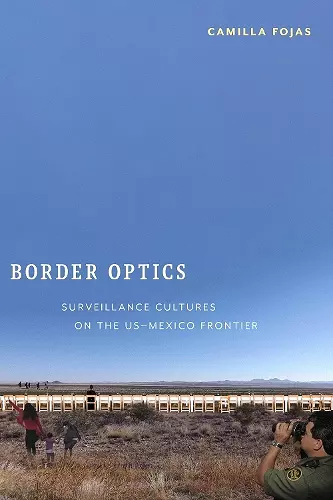Border Optics
Surveillance Cultures on the US-Mexico Frontier
Format:Hardback
Publisher:New York University Press
Published:8th Jun '21
Currently unavailable, and unfortunately no date known when it will be back

Examines how the US-Mexico border is seen through visual codes of surveillance
When Donald Trump promised to "build a wall" on the U.S.-Mexico border, both supporters and opponents visualized a snaking barrier of concrete cleaving through nearly two thousand miles of arid desert. Though only 4 percent of the US population lives in proximity to the border, imagining what the wall would look like came easily to most Americans, in part because of how images of the border are reproduced and circulated for national audiences.
Border Optics considers the US-Mexico border as one of the most visualized and imagined spaces in the US. As a place of continual crisis, permanent visibility, and territorial defense, the border is rendered as a layered visual space of policing—one that is seen from watchtowers, camera-mounted vehicles, helicopters, surveillance balloons, radar systems, unmanned aerial vehicles, and live streaming websites. It is also a space that is visualized across various forms and genres of media, from maps to geographical surveys, military strategic plans, illustrations, photographs, postcards, novels, film, and television, which combine fascination with the region with the visual codes of surveillance and survey.
Border Optics elaborates on the expanded vision of the border as a consequence of the interface of militarism, technology, and media. Camilla Fojas describes how the perception of the viewing public is controlled through a booming security-industrial complex made up of entertainment media, local and federal police, prisons and detention centers, the aerospace industry, and all manner of security technology industries. The first study to examine visual codes of surveillance within an analysis of the history and culture of the border region, Border Optics is an innovative and groundbreaking examination of security cultures, race, gender, and colonialism.
"As historically enduring and salient as borders and border discourses have been, they remain a crucial topic of study—for their deployment has life and death consequences for millions around the globe. Drawing on a creative combination of Border and Surveillance Studies, Camilla Fojas proposes the concept of 'borderveillance' to encourage us to critically assess the imperial significations and material outcomes of the ongoing struggle of human flow at the Mexico-US border. This original approach expands our understanding of the border while creating a visual archive of racial capitalism at work." (Angharad N. Valdivia, author of Latino/as in the Media ) "An incisive, brilliant, and deep analysis of what Fojas terms the 'culture, politics and infrastructure of borderveillance.' With groundbreaking and rigorous research, Fojas demonstrates the ways that the policing of the US-Mexico border is an optical project, one intimately bound up with histories of colonialism, racial capitalism, and genocidal logics. Extending the groundbreaking work of multiple theoretical frameworks from critical race theory to feminist surveillance studies, Border Optics thinks about how dominant modes of seeing produce new technologies aimed at automating and intensifying existing forms of 'racial surveillance capitalism.' In this time of intensified white supremacy and policing at the US-Mexico border, Fojas's work shows the violence produced by borderveillance, and ruminates on alternatives to a dronified future." (Shoshana Amielle Magnet, author of When Biometrics Fail: Gender, Race, and the Technology of Identity ) "
[T]his book offers a welcomed perspective to analyze the culture of border security and how
this culture has shaped border technologies within the security regime… Fojas provides an in-depth account of border surveillance.
ISBN: 9781479806980
Dimensions: unknown
Weight: unknown
224 pages